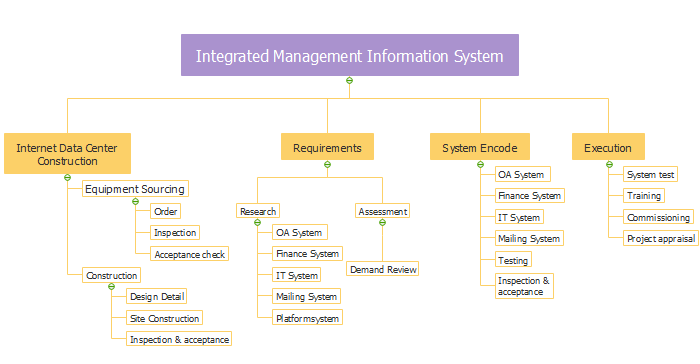What is Work Breakdown Structure? - Definition, Uses and Benefits
Here elaborates the basic knowledge of Work Breakdown Structure (WBS) along with its main uses and benefits.
Work breakdown structure is popular and widely used in managing large projects. But, do you know what the work breakdown structure is, how it works and what exactly its main features are? This page illustrates what definitely work breakdown structure is and what its main uses are.
Definition - What is Work Breakdown Structure?
Work breakdown structure (abbreviated as WBS) is the core step in project management. It is put forward in 1993 aiming to make the big project more manageable in details. To be more specific, WBS is a structural schematic diagram that decomposes tasks layer by layer according to an internal structure or an implementation process. It breaks down the project into several relatively independent, single content, and easy accounting work units. A great work breakdown structure will lead to better team productivity and comprehensive project management.

Main Uses of Work Breakdown Structure
Work breakdown structure is widely used for different occasions. Those uses could be summarized as 3 tools as follow:
- WBS is a planning tool to describe thoughts and ideas. It helps project managers and their teams identify and manage project work effectively.
- WBS is a structural design tool that clearly expresses the interconnections between the various project tasks.
- WBS defines milestones that report project completion to senior management teams and clients as a reporting tool for project status.
Benefits of Work Breakdown Structure
WBS graphical nature is a tree diagram which can help product managers predict the outcomes layer by layer. Each layer may originate from a product, a data, service, and any combination. There are many benefits of work breakdown structure in a project. Here are what a product manager may gain from work breakdown structure.
Clarify project responsibilities
WBS is a good way to help project managers focus on the goals and clarify the responsibilities. Each responsibility has its direction to corresponding tasks which can be easily confirmed.
Improve the accuracy of time, cost, and resources
WBC is detailed in the decomposition of tasks so that estimated time, cost, and resources are covered concisely. All the resources related to tasks no matter it is big or small will be broken down accurately.
Establish a framework for further projects
One complete WBS covers effective information for giving instructions to the further projects. Other team members can get into the framework soon and generate their own WBS easily so as to improve efficiency.
Analyze the initial risk of projects
In fact, WBS decomposition layer is not necessarily fixed, and the lowest level of WBS can be determined according to the level of risk.
Define a benchmark for performance management
WBS defines a concise standard for measuring the performances during the whole project. You can monitor from the first layer of overall tasks to the smallest work units.
Build project members commitment
As WBS is the foundation of information communication, you could use it as a basis for budgeting, progressing and describing other aspects of the project which enables all project-related personnel and groups. Thus they are able to understand the work required to complete the project.
You might be also interested in:



评论
发表评论